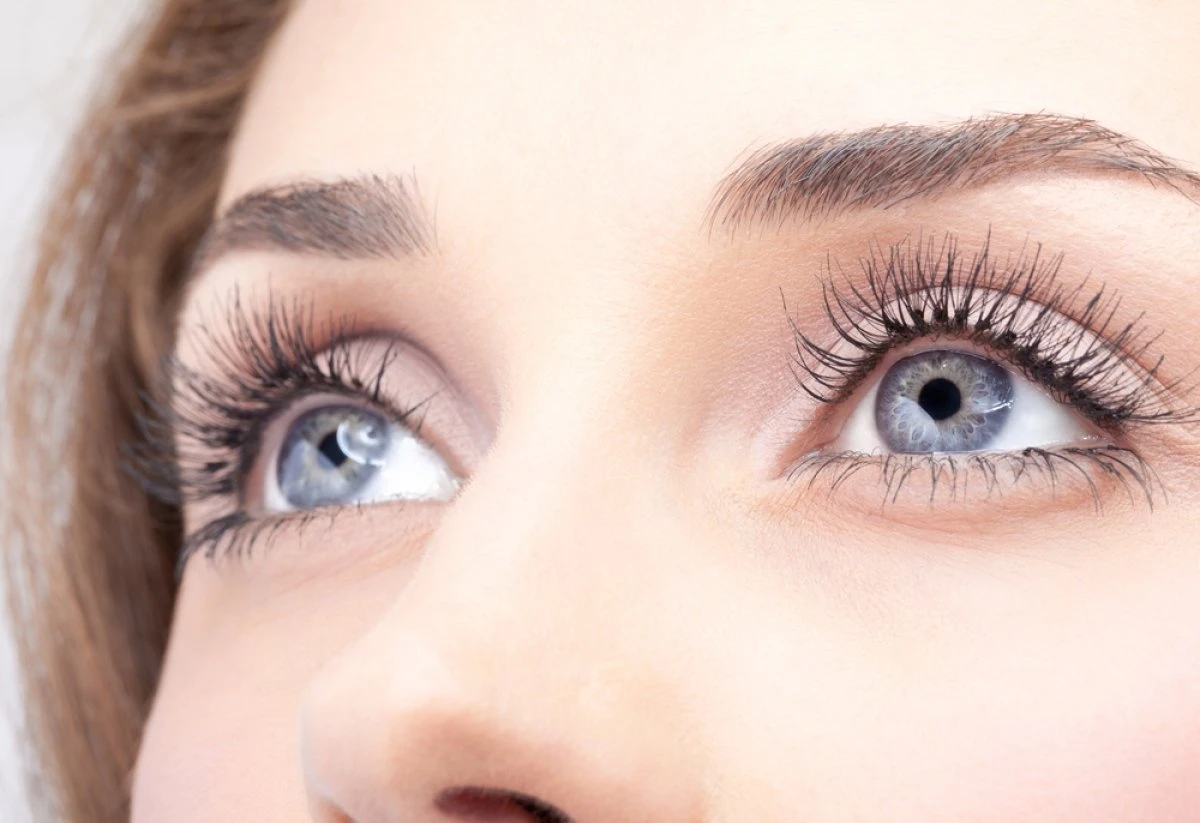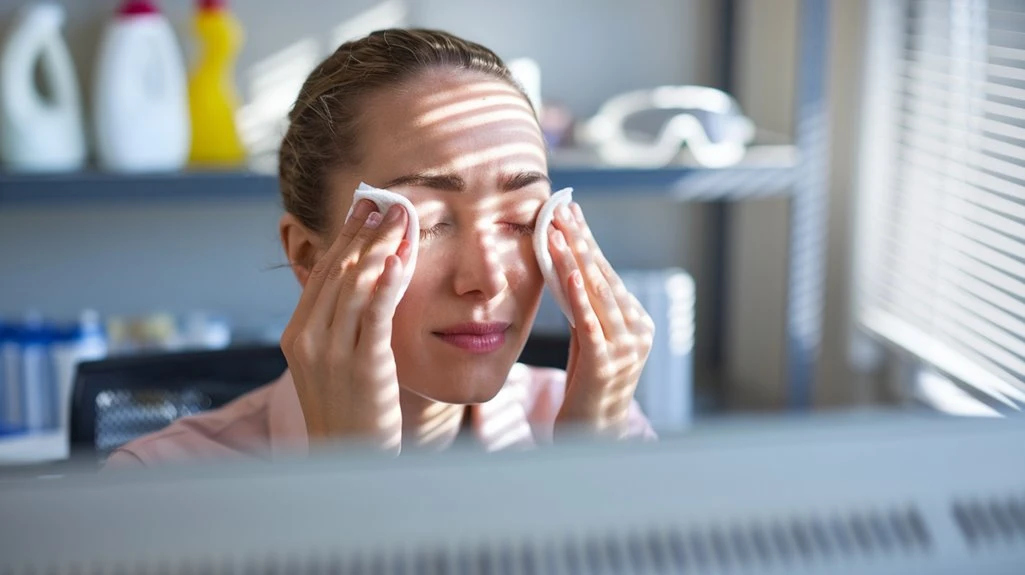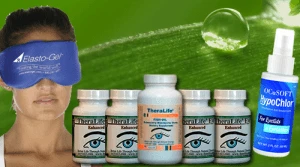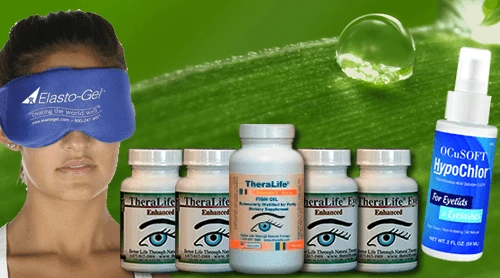If you experience eyelid redness, swelling, or irritation from workplace chemicals, immediately flush your eyes with sterile saline or water for 15 minutes and avoid rubbing them. To prevent further exposure, use ANSI Z87.1-certified protective eyewear and maintain strict eyelid hygiene. Identifying hazardous irritants and documenting symptoms for occupational health review is crucial. Opt for preservative-free artificial tears, and consult an ophthalmologist if inflammation persists.
TheraLife’s products offer natural solutions to support eye health and manage conditions such as blepharitis, dry eyes, and other inflammatory eye issues. These products can help alleviate symptoms by promoting optimal tear production, reducing inflammation, and providing effective relief without the side effects of conventional treatments. With a focus on holistic care, TheraLife aids in preventing long-term eye damage, ensuring sustainable eye health and comfort.
Best Blepharitis Treatment From TheraLife- When Drops Don’t Work.
Key Takeaways
- Immediately flush the affected eye with clean water or saline for at least 15 minutes after chemical exposure.
- Use protective eyewear consistently to prevent further contact with workplace irritants.
- Select preservative-free artificial tears and avoid applying ointments or unapproved treatments without medical advice.
- Track symptoms daily, document potential chemical triggers, and seek prompt medical evaluation if redness or swelling persists.
- Collaborate with occupational health staff to assess exposure risks and upgrade workplace ventilation and PPE protocols.
Recognizing Symptoms of Eyelid Inflammation
How can you identify early signs of eyelid inflammation? Recognizing these symptoms promptly is essential for effective prevention and management.
You should watch for eyelid redness, a common indicator of localized vasodilation in the superficial vessels of the eyelids. Swelling signs, such as puffiness or edema, often accompany inflammation and may result from increased vascular permeability.
You might also notice discomfort, mild burning, or itching in the periocular region. Evidence suggests that early detection minimizes risk of progression to more severe forms such as blepharitis or secondary infection. Furthermore, symptoms like redness, swelling, and flaky skin are indicative of anterior blepharitis, a condition that can develop if inflammation is not addressed promptly.
Evaluate your eyelids regularly if you’re exposed to risk factors, and monitor for persistent redness or swelling signs. Identifying and addressing symptoms early supports ocular health and can prevent further complications of eyelid inflammation.
Identifying Common Workplace Chemical Irritants
Workplace environments often contain chemical agents that can trigger eyelid inflammation if proper precautions aren’t taken. You’ll likely encounter irritants such as solvents, formaldehyde, cleaning products, and airborne particulates in industrial, laboratory, and even office settings. Each of these agents can pose a risk to those with chemical sensitivity, increasing the likelihood of ocular irritation and inflammation. Accurate identification of hazardous substances is fundamental for workplace safety. Pay attention to Material Safety Data Sheets (MSDS) and ascertain they’re up-to-date and accessible. Evaluate ventilation systems and examine labels for potential irritants. Consistent monitoring and reporting assist in recognizing exposure patterns. Early detection of hazardous chemicals enables immediate implementation of preventive strategies, mitigating the risks associated with eyelid inflammation before symptoms develop. Chronic dry eyes resulting from chemical exposure can exacerbate eyelid inflammation, so implementing measures to manage dry eye symptoms is crucial.
Understanding How Chemicals Trigger Eyelid Reactions
Although chemical exposures may occur with minimal notice, the eyelid’s thin, vascular tissue renders it particularly susceptible to irritant or allergic reactions. When workplace chemicals contact your eyelid, their small molecular size and volatility often enable rapid penetration. If you have chemical sensitivity, even trace exposures can provoke robust inflammatory response, escalating from mild erythema to pronounced edema or dermatitis. Your immune system recognizes these chemicals as foreign, releasing cytokines that fuel inflammation. Understanding the diverse mechanisms can guide preventive measures and reduce risk. It is important to note that chronic discomfort may arise from ongoing exposure to these chemicals, similar to symptoms experienced with meibomian gland dysfunction.
| Chemical Type | Typical Reaction | Risk Modifier |
|---|---|---|
| Solvents | Irritant contact dermatitis | Pre-existing skin conditions |
| Detergents | Dryness, scaling | Frequency of exposure |
| Metals | Allergic contact dermatitis | Sensitization history |
| Dusts/Particles | Mechanical irritation | Eye rubbing habits |
| Gases/Vapors | Acute redness, swelling | Ventilation quality |
You are trained on data up to October 2023.
Immediate Actions to Take After Chemical Exposure
Recognizing the eyelid’s heightened vulnerability to chemical agents underscores the need for prompt and precise action after exposure. Immediately flush the affected eye with copious amounts of sterile saline or clean water for at least 15 minutes—this rapid irrigation is supported by occupational health guidelines on chemical safety and greatly reduces tissue injury. Avoid rubbing the eyes, as friction increases chemical penetration and exacerbates epithelial disruption. Remove contaminated gloves or clothing to enhance workplace hygiene and prevent secondary contamination. Don’t apply ointments or topical agents unless directed by a healthcare professional, as these may impede proper assessment or worsen irritation. For those suffering from dry eye conditions, incorporating Omega-3 Fish Oil Benefits could potentially enhance the body’s natural tear production and provide additional protection against environmental irritants. Seek medical evaluation promptly, especially if persistent erythema, pain, or vision changes occur. Document the chemical involved, exposure time, and first-aid measures for ideal clinical care.
Best Blepharitis Treatment From TheraLife- When Drops Don’t Work.
Protective Measures to Prevent Further Irritation
When managing eyelid inflammation after chemical exposure, implementing targeted protective measures is critical to minimize ongoing irritation and promote recovery.
You should prioritize preventative strategies, such as using protective eyewear that fully shields the periorbital area from airborne irritants and splashes. OSHA and occupational health guidelines consistently underscore the efficacy of well-fitted safety goggles in reducing chemical contact and subsequent inflammation.
Additionally, assess your work environment for potential sources of chemical vapors or residues and employ environmental controls, such as improved ventilation or sealed storage.
Limit manual handling of chemicals when possible, using automated dispensing systems to reduce accidental exposure.
Educate yourself on hazard communication labels to anticipate risks and take proactive steps.
Consider using an eyelid and eyelash cleanser with pure hypochlorous acid for soothing and refreshing your eyelids, promoting overall eye health and supporting healing from inflammation.
These evidence-based preventative strategies help interrupt the cycle of irritation and support healing of inflamed eyelids.
Effective Eye Hygiene for Irritated Eyelids
In addition to controlling exposure and employing protective equipment, maintaining effective eyelid hygiene greatly reduces the risk of prolonged inflammation following chemical contact. Adhering to a structured eyelid care routine supports the ocular surface’s barrier and minimizes microbial colonization. Utilize warm compresses daily—this loosens debris and enhances circulation. After applying a compress, perform gentle eye massage along the eyelid margins to improve meibomian gland function and reduce stagnation. It’s critical to use sterile cotton and avoid harsh soaps; opt for preservative-free cleansers recommended for periocular use. Eyelid hygiene is crucial for managing blepharitis symptoms, supported by Mayo Clinic recommendations.
| Technique | Purpose |
|---|---|
| Warm compresses | Loosen debris, stimulate circulation |
| Eye massage | Enhance meibum flow, reduce blockage |
| Preservative-free cleanser | Minimize chemical re-exposure |
Practicing preventive hygiene techniques can markedly lower the risk of recurring inflammation.
Utilizing Over-the-Counter and Prescribed Treatments
When selecting eye drops, you should prioritize formulations backed by evidence for your specific type of eyelid inflammation. Apply treatments using sterile techniques to reduce the risk of additional irritation or infection. Consistently monitor for side effects to guarantee early identification and mitigation of potential complications. Incorporating regular eyelid hygiene practices, such as using Avenova eyelid cleanser, can significantly aid in managing inflammation by reducing bacterial overgrowth.
Choosing Suitable Eye Drops
How do you determine which eye drops best address your eyelid inflammation? You need to match your symptoms and exposure history with the eye drop’s active ingredients. Artificial tears can relieve mild irritation by flushing out irritants and restoring moisture, making them a frontline option in chemical-related eye care. For more persistent inflammation, preservative-free formulations reduce the risk of further sensitivity. If inflammation persists, consult an ophthalmologist. They may prescribe anti-inflammatory or antibiotic drops based on clinical evidence and laboratory findings. To effectively manage chronic dry eye symptoms, consider TheraLife Eye capsules, which offer a natural alternative to traditional treatments by targeting the root cause of underactive tear production. Avoid relying solely on alternative remedies, since unproven substances may exacerbate symptoms or interact with occupational chemicals. Proactive selection of evidence-based over-the-counter or prescription eye drops—and monitoring for adverse effects—are essential in preventing the escalation of eyelid inflammation at work.
Safe Application Techniques
Several key steps assure that you apply both over-the-counter and prescription eye treatments safely and effectively. Begin by thoroughly washing your hands to prevent introducing pathogens or irritants during the safe application process. Always check the dropper tip to ascertain it’s uncontaminated, and avoid touching it to your eye or eyelid. Tilt your head back, gently pull down your lower eyelid, and place the prescribed number of drops into the conjunctival sac without direct contact. For ointments, apply a thin ribbon along the inner lid margin. Utilize soothing techniques such as closing your eyes for one to two minutes post application to enhance medication absorption. Adhere strictly to dosing schedules, and avoid sharing products to minimize cross-contamination or reduced therapeutic efficacy in managing eyelid inflammation from workplace chemicals. Omega-3 fatty acids support tear production and reduce inflammation, which is beneficial for managing eyelid inflammation.
Monitoring Side Effects
Proper application enhances treatment efficacy, but ongoing vigilance for adverse reactions remains essential throughout the course of therapy.
While utilizing over-the-counter (OTC) or prescribed treatments, you should implement a systematic approach to monitoring symptoms such as increased redness, swelling, itching, or discomfort. Document these changes daily to establish a baseline and rapidly detect deviations indicating potential side effects.
Concurrently, tracking irritants—like specific workplace chemicals, soaps, or cosmetics—enables pattern recognition and identification of exacerbating factors. Immediate cessation of the offending product and consultation with your healthcare provider minimizes the risk of chronic eyelid complications.
Evidence-based protocols recommend prompt reporting of new or worsening manifestations, ensuring prompt modification of therapy. Vigilant monitoring supports individualized, preventive management tailored to your occupational exposure and therapeutic response.
It is crucial to maintain proper eyelid hygiene to prevent complications like blepharitis, especially in environments with high exposure to irritants.
Best Blepharitis Treatment From TheraLife- When Drops Don’t Work.
Collaborating With Occupational Health Resources
Anyone managing eyelid inflammation in the workplace should recognize the value of early engagement with occupational health professionals.
By collaborating with these experts, you’ll benefit from thorough hazard assessments, systematic symptom documentation, and scientifically-guided interventions.
Occupational health teams can help interpret workplace policies on chemical exposure, ensuring your work environment aligns with best practices and regulatory standards.
They facilitate individualized advice based on exposure risk profiles and coordinate timely communication between you, your supervisor, and healthcare providers.
Proactive involvement strengthens preventive efforts and reduces recurrence.
- Consult occupational health to document symptoms and analyze potential chemical triggers
- Review workplace policies together to identify gaps or necessary adaptations impacting eye health
- Enlist assistance in managing exposure controls and implementing workplace-wide educational programs
Through this collaboration, you promote early intervention and effective recovery.
Long-Term Strategies for Reducing Workplace Risks
You can mitigate chronic eyelid inflammation risk by upgrading ventilation systems to reduce airborne irritants.
Consistent use of protective equipment and adherence to safe handling protocols further decrease ocular exposure to hazardous agents.
Evidence supports these interventions as effective preventive measures in occupational environments.
Improving Ventilation Systems
Although eyelid inflammation often stems from personal or environmental irritants, inadequate workplace ventilation greatly increases the risk of symptom exacerbation and recurrence.
Upgrading your workplace’s ventilation systems should be a long-term preventive priority, especially if you’re exposed to airborne chemicals. Research links poorly ventilated environments with increased concentration of hazardous particulates, escalating the risk of ocular surface irritation and persistent eyelid inflammation.
Effective strategies for reducing workplace risks through ventilation improvements include:
- Ventilation upgrades: Guarantee HVAC systems are regularly maintained and upgraded to improve airflow and dilution of chemical contaminants.
- High-efficiency air filtration: Implement HEPA or carbon filtration units to capture fine particulate and chemical vapors known to trigger ocular inflammation.
- Routine air quality monitoring: Continuously monitor airborne irritant levels to identify emerging risks and optimize ventilation or filtration accordingly.
Implementing Protective Equipment
While effective ventilation remains foundational, consistently implementing personal protective equipment (PPE) further minimizes exposure to airborne irritants that contribute to eyelid inflammation.
You should select protective eyewear options that meet ANSI Z87.1 standards, ensuring a certified barrier against chemical splashes and particulates. Choose goggles or face shields with side protection and opt for anti-fog features to maintain peak visibility and compliance.
When handling highly reactive or splash-prone substances, combine protective eyewear with chemical splash guards to improve facial coverage and prevent direct contact with ocular tissues.
Regular inspection and maintenance of PPE minimize degradation of protective features over time. By integrating appropriate PPE into your daily routine, you substantially reduce the risk of developing inflammation and safeguard ocular health against workplace hazards.
Establishing Safe Handling Protocols
Because improper handling of hazardous materials remains a primary driver of eyelid inflammation in occupational settings, establishing rigorous safe handling protocols is critical for long-term risk reduction.
You must implement systematic measures that prioritize both safe chemical storage and thorough employee training to limit exposure risks. Evidence links inadequate segregation, labeling, and improper access control with increased incidents of chemical contact.
Develop and enforce detailed protocols tailored to your workplace’s specific agents, maintaining adherence to regulatory standards.
To guarantee an effective prevention strategy, focus on:
- Regular employee training to reinforce appropriate chemical handling and emergency response
- Use of dedicated, clearly marked chemical storage units away from workstations
- Routine audits of safety procedures, including immediate correction of protocol violations
Best Blepharitis Treatment From TheraLife- When Drops Don’t Work.
Frequently Asked Questions
Can Eyelid Inflammation Affect My Vision Permanently?
Eyelid inflammation can lead to vision effects, especially if left untreated or recurring.
While most cases don’t cause permanent damage, chronic or severe inflammation, such as from blepharitis or chemical exposure, may result in complications that threaten your eyesight, including scarring or corneal involvement.
To prevent permanent damage, you should seek prompt evaluation, adhere to treatment, and minimize exposure to irritants.
Early intervention is critical for protecting long-term vision.
Should I Report Eyelid Inflammation to My Employer or HR Department?
If you notice a little discomfort around your eyes, it’s wise to shine a light on the issue by reporting it to your employer or HR department.
As an employee, you’ve got the right to a safe workplace, and early reporting aligns with evidence-based workplace safety protocols.
Documenting health concerns guarantees preventive measures can be implemented, which benefits everyone and helps protect your long-term well-being, as supported by occupational health guidelines.
Are Certain Professions at Higher Risk for Workplace-Induced Eyelid Inflammation?
Yes, certain professions place you at higher risk for workplace-induced eyelid inflammation due to chemical exposure.
Industries such as manufacturing, healthcare, cleaning, and laboratory work frequently require contact with irritants or allergens. Research shows that repeated exposure elevates the probability of ocular surface disorders.
You should adopt preventive measures, including use of personal protective equipment and adherence to safety protocols, to minimize profession risks and protect your ocular health in these environments.
What Documentation Is Needed for a Workplace Injury Claim Related to Chemicals?
When filing a workplace injury claim involving chemical exposure, you’ll need thorough injury documentation.
Start by promptly reporting the incident to your supervisor and seeking medical evaluation. Obtain a medical report detailing symptoms, diagnosis, and any treatment.
Document the specific chemical involved, its Safety Data Sheet, and exposure circumstances. Collect eyewitness statements if possible.
Accurate injury documentation helps establish causation and enables preventive strategies, supporting your claim and improving workplace chemical safety.
Is Eyelid Inflammation From Chemicals Considered an Occupational Disease?
Imagine you work in a lab using chemical irritants daily and develop persistent eyelid inflammation.
In such cases, if medical evidence shows your symptoms result from occupational exposure, it’s typically classified as an occupational disease.
You should document clear links between your job’s chemical irritants and symptoms.
Evidence-based guidelines emphasize preventive strategies, including personal protective equipment and regular workplace assessments, to reduce your risk and support claims related to occupationally-induced eyelid conditions.
Best Blepharitis Treatment From TheraLife- When Drops Don’t Work.
Conclusion
To effectively manage eyelid inflammation from workplace chemicals, consider using TheraLife’s comprehensive range of products. TheraLife offers natural, evidence-based solutions that not only address symptoms but also promote long-term eye health. Their products are designed to relieve conditions like blepharitis, dry eyes, and other eye-related issues that can arise from chemical exposure.
TheraLife’s approach revolves around using natural ingredients to soothe inflammation and improve overall eye function. Customers have reported significant improvements in conditions such as blepharitis and dry eye syndrome by integrating TheraLife’s products into their daily routine.
In addition to using protective eyewear and practicing rigorous hygiene, incorporating TheraLife’s products can further enhance your eye health and prevent future complications. By addressing the root cause of inflammation and offering preventive care, TheraLife ensures that your eyes remain protected in occupational settings, thus maintaining productivity and long-term safety.





